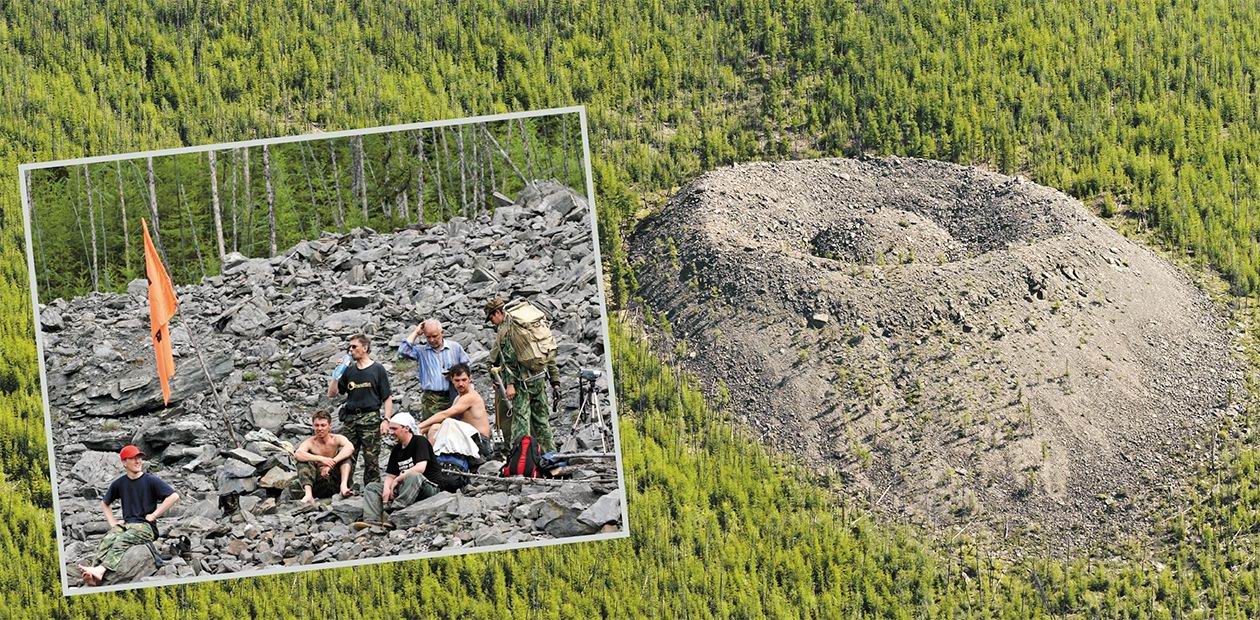Patom crater – terrestrial or celestial?
Geologist V.V. Kolpakov discovered this hillock at a distance of 180 km from the town of Lensk, almost on the border of Yakutia and Irkutsk region, in 1949. A great diversity of hypotheses for the origin of the crater have been proposed, such as meteorite impact, an extinguished volcano and even... a young kimberlite pipe. Former expeditions produced more questions than answers. Finally, joint efforts of two institutions of the Siberian Branch of the Russian Academy of Sciences and two Irkutsk universities have lead to certain conclusions. With the help of geological mapping and dendrochronological analysis scientists have reproduced the sequence in the formation of the crater zones, whereas geochemical studies of rock samples taken within and near the crater have revealed the zoning of chemical elements. Based on the results obtained, one of the hypotheses has been confirmed
Rare odd-shaped structures always attract attention. Such an enigmatic object is the 160-meter-wide crater discovered in the middle of the last century on the Patom Highland in the upper reaches of the Lena River. What powerful forces created it? Should we expect a recurrence of some hazardous natural phenomena in this region? Or, on the contrary, should we look around for mineral resources?
The well-organized recent expeditions have revealed facts confirming the volcanogenic origin of the crater and determined the time of its sequential formation.
A bit of history
More than 60 years have passed since the discovery of an unusual crater on the north of Irkutsk region (Bodaibo district). Vadim Kolpakov, the geologist from Irkutsk who discovered this extraordinary natural phenomenon, speculated that Patom сrater was produced by a meteorite impact (Kolpakov, 1951).
In 1963, the Siberian Committee on Meteorites of the USSR Academy of Sciences sent a volunteer expedition to Patom crater. After the investigations, there was no consensus of opinion among scientists on the processes responsible for the crater’s genesis. V. V. Kolpakov together with S. A. Yasev, an astronomer from the Observatory of Irkutsk State University, noted that such a crater could have been formed only by an impact of a super-dense meteorite, which had never been observed before (Kolpakov, Yasev, 2007).
However, as early as in 1951, the famous geologist S. V. Obruchev expressed doubt about the meteorite origin of Patom crater. According to his hypothesis, the crater could have formed as a result of steam-and-gas outbreak from a great depth in the area affected by tectonic faults.
Despite the interest shown towards this natural object during the last years, detailed information about the rock types composing the crater was obtained only during the complex expeditions organized in 2006 and 2008, when Patom crater was studied collaboratively by geologists and geochemists from the Institute of Geochemistry SB RAS, geophysicists from Irkutsk State Technical University, biologists from the Siberian Institute of Plant Physiology and Biochemistry SB RAS, as well as by astronomers from the Observatory of Irkutsk State University (Antipin et al., 2006, 2008).
During these investigations, a geological map was first drawn and results of geological, petrographic and geochemical studies of the rocks within and around the crater were obtained, which in the end has allowed making certain conclusions about the conditions under which this enigmatic cone had formed.
Age-old rings
Patom crater has an unhomogeneous geological structure. The photographs show distinctively its four basic parts: outer slope of the cone, ring swell, ring trench, and central hill.
All the parts of the crater are composed mainly of sedimentary rocks. Carbonate rocks predominantly occurring around the crater have average chemical composition characteristic of typical limestone with calcium content higher than 50 % (calculated as CaO). Carbonate rocks sampled from all zones of the crater have no significant difference in their compositions.
The most important morphological feature is the ring swell (the most elevated part of the crater), separated by a shallow topographic low in two parts formed at different times.
The inner ring swell formed earlier than the outer one. Besides limestones, it includes single blocks of terrigenous rocks, namely, schists and sandstones. Their so called debris, containing coarse fragments greater than 1 mm in size, is often covered with moss. Here and there, there are larch trees growing on it.
The outer (later stage) ring swell, unlike the inner one, does not contain any terrigenous rocks. It is composed of slightly weathered massive crystalline limestones; on its surface, there are single young trees.
The top of the central hill is composed of minimally weathered massive crystalline limestones. This part of the crater apparently formed last.
Zoning of the Patom crater rocks contradicts the impact hypothesis of its formation. Indeed, a meteorite impact on the Earth surface leads to a simultaneous formation of crater parts. Characteristic of this case is a special “impact” structure with a flatter trench and a low ring swell.
Patom crater, on the contrary, looks like a deposition truncated cone with steep slopes and a pit on the top. Such morphology is typical of contemporary volcanic structures. The diameter to height ratio (in the range of 3—8) is also very typical of the structures of endogenic origin (i. e., initiated by deep-seated processes in the Earth).
Comparison of the results of up-to-date measurements with the data obtained half a century ago (when the crater was discovered) shows that the crater is subjected to destruction. For instance, the extent of the talus slope has increased, which points to a significant influence of weathering processes.
Sandstones and schists are consolidated sedimentary rocks mainly consisting of silicate minerals. Schists has a layered structure, whereas sandstone is composed of grains (cemented sand).Limestones are sedimentary rocks deposited in water environment. Generally, they include calcium carbonates and other salts of carbonic acid.
Carbonatites are endogenic rocks that have predominantly carbonate composition (calcite, siderite, and dolomite) and are genetically related to complexes of ultrabasic (alkali) rocks
Speaking stem disks
To determine the conditions of Patom crater formation, it is very important to identify the age of its ring structure elements. As the crater has trees growing on its surface, such as sparse larches, an appropriate dating method is dendrochronological analysis based on counting the number and measuring the thickness of the tree rings.
Studies of the tree samples cut in 2006 lead to the conclusion that the loose rock material of the crater outer part had formed not later than in 1770 since the oldest tree appeared on it at that time. The age of the debris on the early stage ring swell is about 250—300 years (Voronin, 2006; Antipin et al., 2008).
In 2008, in order to determine the exact age of the crater, a bulk selection of stem disks was made from the oldest larch trees growing several meters from the northern side the crater’s outer slope composed of massive crystalline limestones of the late stage ring swell.
The thorough search conducted on the outer slope has not revealed any trees older than 480 years. This is noteworthy because the middle age of larch tress in the area is circa 600 years, and from time to time one can see 1100-year-old trees. Moreover, next to the northern margin of the crater, a lot of trunks were bent and one of the trees was lying on the surface of the outer slope alive as some of its roots were still under the ground.
Therefore, we can reasonably assume an active ground movement (i.e., a local earthquake) happening in this area about 500 years ago. This resulted in a mass fall of the trees, after which a new generation of larch trees grew.
Notice that most of the trees near the northern margin of the talus slope have various anomalies in the width of rings, bent trunks and traces of mechanical damage (e. g., scars on the trunks from stones), which took place in 1841 or 1842. Obviously, in these years the studied trunks lived through a catastrophic event that occurred in the Patom сrater area. It affected the root systems: as a result, some of the trees were bent, some suffered a mechanical damage, and a few demonstrated a sharp decrease in radial increment.
Since no trees dried after a fire were found, the possibility of tree damage as a result of a forest fire was completely excluded. As the crippled and broken trees were located next to the slope margin, they must have been damaged by boulders rolling down the slope during the last stage of the outer ring swell formation.
Therefore, the crater’s date of birth refers most likely to the end of the 15th or beginning of the 16th century, and the formation of the late stage ring swell – to 1841 or 1842, in other words, over 300 years after the crater began to develop.
And the smell of sulphur…
Geochemical analysis of rocks and minerals composing a geological object can also supply clues to its origin. To put it simply, “underground” and “celestial” materials vary considerably in their chemical composition.
To solve the problem of Patom crater genesis, samples of all main types of rocks were collected on the crater and around it. Their chemical composition was analyzed at the Institute of Geochemistry SB RAS using the methods of inductively coupled plasma mass spectrometry (ICP MS) and X-ray fluorescence analysis (X-RFA).
The accepted criterion of “celestial” origin of the material is a specific distribution pattern (more regular in comparison with terrestrial rocks) of metals with atomic numbers in the range of 21—30 (e. g., V, Cr, Fe, Co, Ni, Cu). Nickel is an indicator element due to its highest content in meteorites, which results in the formation of unique minerals of nickel and iron (e.g., kamacite and taenite).
The results of the chemical analysis showed that terrigenous rocks of the early stage ring swell are significantly depleted of these metals in comparison with the rocks outside the crater. For example, the content of nickel in the sandstones is a half, and in the schists almost one third of the mean content of this element in the country rocks surrounding the crater. Such a concentration distribution pattern contradicts the meteorite impact hypothesis.
On the other hand, separate zones of the crater, distinguished on the basis of geological and petrographic data, are also different in their geochemical characteristics. Such zoning is typical of rocks related to endogenic processes.
Of greatest interest is the composition of selected samples of terrigenous rocks inside of the crater deposition cone. These rocks were carried up from deep horizons (horizontal layers of the Earth crust) during the crater formation. It has been found out that the content of alkaline-earth elements (Ca, Sr, Ba) in the sandstones and schists is considerably, sometimes more than 1.5 times higher than that in the country rocks. These metals come with the solutions from great depth and in the reaction with carbon dioxide СО2 they are accumulated in various rocks in the form of carbonate minerals.
Most importantly, in some sandstone blocks inside the crater a higher total concentration of rare-earth elements (REE) has been found, up to 557 ppm in single samples. This is six times higher than REE concentration in the sandstone around the crater. The sandstones have proved to contain sphen, zircon, apatite and fluorite, able to accumulate REE. Application of the hondrite normalization method has shown that the REE distribution pattern and concentration level of some carbonatized sandstones are similar to those in the rocks of contemporary carbonatite volcanoes of the East-African rift zone.
Besides carbonates containing carbon in its oxidized state (СО2), the crater rocks comprise reduced forms of carbon and hydrogen (in the form of СО and Н2), which indicates a deep source of inclusions of the carbonate minerals (Letnikov et al., 1980). The highest content of СО (around 9 milliliter in one gram of solid matter) was recorded in the limestones of the central hill and ring swell, the parts of the crater where the blocky material of the deposition cone could have moved up along a deep vertical channel.
In geochemistry, the method of chondrite normalization is applied for the description of the relative REE content. The concentration of each element is divided by its average concentration in chondrites (material of stony meteorites). The source of the “rare earth” areas is characterized by the obtained spectrum of relative REE concentration values and its indicator (ratio La/Yb)Sulphur is considered to be one of the basic volcanic elements. Although the general sulphur content in most crater rocks is not high (less than 0.1 %), among the carbonate rocks of the crater, the limestones of the late stage ring swell and central hill have the highest sulphur concentration, up to 0.3 %. Such an increase in the concentration is evidence of sulphur accumulation during the last stages of Patom crater development.
Our sensory organs also confirm the presence of sulphur in its reduced state: there is a strong smell of rotten eggs on the ring swell of the crater, which indicates the presence of hydrogen sulfide.
Geochemical evidence for the presence of meteorite matter is high concentration of nickel and other chemical elements close in atomic number (scandium, chrome, vanadium, iron, cobalt, copper, etc.)Thus, the endogenic origin of Patom crater can be considered to be proved. Attesting to its volcanogenic nature are the geological, petrographic and geochemical data obtained.
Since rocks rich in strontium and rare-earth elements have been found, subsequent detailed geological and geochemical studies of the crater are not only of scientific but also of practical interest.
In order to learn about the deep sources of the processes that created this remarkable natural phenomenon, drilling activities are necessary. These, we hope, is work for the near future.
Gaseous substances (СО, Н2, Н2S) come from the sources located deep in the mantle (~30 km), which are characterized by reduced electrochemical conditions.In near-surface layers of the Earth crust, these substances are oxidized to CO2, H2O, S and SO2 by oxygen O2 penetrating from the air.
The carbon dioxide CO2 takes part in the formation of carbonate minerals
References
Antipin, V. S. et al. Expeditionary survey of Patom crater // Izbrannyie problemy astronomii. Proceedings of “The Sky and The Earth” research-to-practice conference dedicated to the 75th anniversary of Irkutsk State University Astronomical Observatory. Irkutsk. 2006. P. 163—168.
Antipin, V. S. et al. Patom crater in East Siberia // Priroda, 2008. No. 9. P. 69—75.
Antipin, V. S., Fyodorov, А. М. The origin of Patom сrater (East Siberia) from geological and geochemical data // Doklady RAS, 2008. V. 423. No. 3. P. 361—366.
Kolpakov, V. V. The enigmatic crater in Patom Highland // Priroda, 1951. No. 1—2. P. 58—61.
Kolpakov, V. V., Yasev, S. A. Patom cone // Zemlya i Vselennaya, 2007. No. 1. P. 57—65.
Letnikov, F. A. et al. Fluid regime of the mantle rocks formation. Novosibirsk: Nauka, 1980. 143 pp.
Portnov, A. M. The crater on the Patom Plateau // Priroda, 1962. No. 1. P. 102—103.
Portnov, A. M. Is Patom сrater a trace of the Tunguska phenomenon? // Zemlya i Vselennaya, 1993. No. 1. P. 77—81.
Samoilov, V. S. Geochemistry of carbonatites. Moscow: Nauka, 1984. 191 pp.
Voronin, V. I. Preliminary results of the dendrochronological analysis of Dahurian larch saw cuts selected in the area of Patom сrater // Izbrannyie probleny astronomii. Proceedings of “The Sky and The Earth” research-to-practice conference dedicated to the 75th anniversary of Irkutsk State University astronomical observatory. Irkutsk. 2006. P. 169—176.
and financial support, as well as A. K. Klimova, L. A. Chuvashova, and Ye. V. Smirnova,
members of the analytical centers at the Institute of Geochemistry SB RAS
and Institute of the Earth Crust SB RAS
D. Semenov, M. Antipin, and V. Korotkoruchko (Irkutsk)








